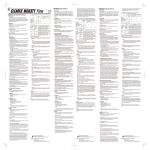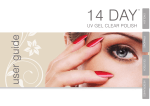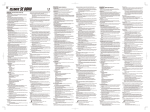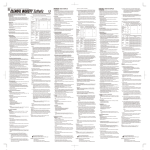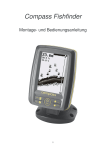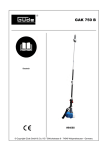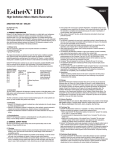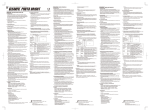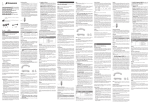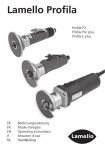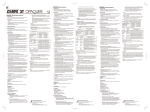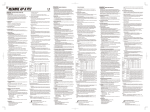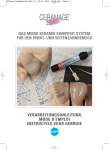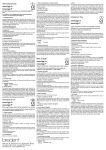Download modo de empleo español mode d`emploi français instructions for
Transcript
002 CS2660-EU1 FRANÇAIS MODE D'EMPLOI DENTAL LIGHT-CURED RESTORATIVE COMPOSITE ENGLISH INSTRUCTIONS FOR USE I. INTRODUCTION CLEARFIL MAJESTY Esthetic PLT (PLT: Pre-loaded tip) is a light-cure, radiopaque restorative composite resin which provides accurate color matching, high polish ability and excellent physical properties, making it ideal for both anterior and posterior restorations. It is formulated with optimal viscosity assuring easy handling and placement. CLEARFIL MAJESTY Esthetic PLT, with its' special dispensing system, can be quickly and conveniently placed directly into the cavity. II. INDICATIONS CLEARFIL MAJESTY Esthetic PLT is indicated for the following restorative applications: • Direct restorations for anterior and posterior teeth (Class I - V cavities) • Direct veneers • Correction of tooth position and tooth shape (e.g. diastema closure, dwarfed tooth, etc.) • Intraoral repairs of fractured crowns / bridges III. CONTRAINDICATION Patients with a history of hypersensitivity to methacrylate monomers IV. INCOMPATIBILITIES Do not use eugenol containing materials for pulp protection or temporary sealing, since the eugenol could retard the bonding system curing process. V. PRECAUTIONS 1. Safety precautions 1. Avoid use of the product for patients with a history of hypersensitivity to methacrylate monomers. 2. If any hypersensitivity occurs, such as dermatitis, discontinue use of the product and consult a physician. 3. Wear gloves or take other appropriate protective measures to prevent the occurrence of hypersensitivity that may result from contact with methacrylate monomer. 4. Use caution to prevent the product from coming in contact with the skin or getting into the eye. Before using the product, cover the patient's eyes with a towel to protect the patient's eyes from splashing material. 5. If the product comes in contact with human body tissues, take the following actions: < If the product gets in the eye> Immediately rinse the eye with copious amounts of water and consult a physician. < If the product comes in contact with the skin or the oral mucosa> Immediately wipe it off with a cotton pledget moistened with alcohol or gauze and rinse with copious amounts of water. 6. Use caution to prevent the patient from accidentally swallowing the product. 7. Avoid looking directly at the dental curing light when curing the product. 8. Avoid using the same tip for different patients to prevent cross contamination. Discard the tip after use and sterilize the dispenser according to the dispenser Instruction for Use. 9. For infection control reasons, PLT tips are for single use only. 2. Handling and manipulation precautions 1. Do not use the product in conjunction with the other composite resin. Mixing materials may cause a change in physical properties, possibly a decrease, from the properties expected. 2. If the adherent surface extends to uncut enamel, apply a phosphoric acid etching agent (e.g. K-ETCHANT GEL) and leave it in place for 10 seconds before washing and drying. 3. Amalgam or other lining material remaining in the cavity will prevent the passage of light and the polymerization of the product. Completely remove any lining material when preparing the cavity. 4. When light curing the product, note the light curing depth in this Instructions for Use. 5. The emitting tip of the dental curing light should be held as near and vertical to the resin surface as possible. If a large resin surface is to be light cured, it is advisable to divide the area into several sections and light-cure each section separately. 6. Low light intensity causes poor adhesion. Check the lamp for service life and the dental curing light guide tip for contamination. It is advisable to check the dental curing light intensity using an appropriate lightevaluating device at appropriate intervals. 7. The paste should be used as soon as practicable after being dispensed from the tip. If the paste is to be left for a while before use, it should be covered with a light blocking plate. 8. The product should be returned to room temperature before dispensing, if it has been taken out of a refrigerator. Failure to do this might cause breakage of the tip. 9. Squeeze the dispenser with a slow, steady pressure. Excessive force is not necessary. 10. The use of the product is restricted to licensed dentist. 3. Storage precautions 1. Do not use the product after the expiration date. Note the expiration date on the outside of package. 2. The product must be stored at 2 - 25 °C / 36 - 77 °F when not in use. 3. Keep away from extreme heat, direct sunlight. 4. The product must be stored in proper places where only dental practitioners can access it. VI. SHADES SYSTEM AND COMPONENTS 1. Shades CLEARFIL MAJESTY Esthetic PLT is available in 17 shades; A1, A2, A3, A3.5, A4, B2, B3, C3, HO, E, XL, OC, OA2*, OA3*, OA4*, T, AM * OA2, OA3 and OA4 are opaque shades. 2. Components Please see the outside of the package for contents and quantity. • CLEARFIL MAJESTY Esthetic PLT • CLEARFIL MAJESTY Esthetic Shade guide 3. Ingredients Principal ingredients; • Silanated barium glass filler • Pre-polymerized organic filler • Bisphenol A diglycidylmethacrylate (Bis-GMA) • Hydrophobic aromatic dimethacrylate • dl-Camphorquinone [NOTE] The total amount of inorganic filler is approx. 40vol%. The particle size of inorganic fillers ranges from 0.37 μm to 1.5 μm. VII. CLINICAL PROCEDURES Method. A • Direct restorations for anterior and posterior teeth (Class I - V cavities) • Direct veneers • Correction of tooth position and tooth shape (e.g. diastema closure, dwarfed tooth, etc.) 1. Cleaning tooth structure Be sure the cavity is adequately cleaned. An adequately cleaned cavity assures maximum adhesive performance. 2. Moisture control Avoid contamination of the treatment area from saliva or blood to produce optimal results. A rubber dam is recommended to keep the tooth clean and dry. 3. Cavity preparations Remove any infected dentin and prepare the cavity in the usual manner. 4. Pulp protection Any actual or near pulp exposure could be covered with a hard setting calcium hydroxide material. There is no need for cement lining or basing. Do not use eugenol materials for pulp protection. 5. Tooth surface treatment and bonding Tooth surface treatment and bonding should be performed according to Instructions for Use of the bonding system used (e.g. CLEARFIL TRI-S BOND). 6. Placement and light curing of CLEARFIL MAJESTY Esthetic PLT 6-1. If necessary, the application of a flowable composite resin (e.g. CLEARFIL MAJESTY Flow) to the cavity as an initial layer is optional (Refer to its' Instructions for Use). This layer should be polymerized prior to placing the first layer of CLEARFIL MAJESTY Esthetic PLT. 6-2. Select an appropriate shade corresponding with the shade of the tooth to be treated using the CLEARFIL MAJESTY Esthetic Shade guide. Two or more shades may be combined to achieve a better overall shade match. 6-3. Place a PLT tip of the product into the dispenser barrel according to the Instructions for Use for dispenser. The tip may be rotated to provide the proper angle for delivery into the cavity. [CAUTION] Squeeze the dispenser with a slow, steady pressure. Excessive force is not necessary. Discard the tip after use and sterilize the dispenser according to its' Instructions for Use. 6-4. Place the chosen shade product into the cavity, and light-cure the resin with a dental curing unit* following the table. Table: Relation between curing time and depth of cure for each dental curing unit. Type Curing time (Sec) Conventional halogen* 20 Fast halogen* 10 Plasma arc* 5 LED* 20 *Dental curing unit Type Light source Depth of cure (mm) T, AM A1, A2, A3, A3.5, A4, B2, B3, C3, HO, E, XL, OC 2,0 OA2, OA3, OA4 1,5 1,0 Wavelength range and light intensity Conventional halogen Halogen lamp Light intensity2) of 300 - 550 mW/cm2 in wavelength range from 400 - 515 nm Fast halogen Halogen lamp Light intensity of more than 550 mW/cm in wavelength range from 400 - 515 nm Xenon lamp Light intensity3) of more than 2000 mW/cm2 in wavelength range from 400 - 515 nm, and light intensity of more than 450 mW/cm2 in wavelength range from 400 - 430 nm Blue LED1) Light intensity2) of more than 300 mW/cm2 in wavelength range from 400 - 515 nm Plasma arc LED 2) 2 1) Peak of emission spectrum: 450 - 480 nm 2) Evaluated according to ISO 10650-1. 3) Wavelength distribution and light intensity values measured with a spectro-radiometer calibrated using an IEC or the NIST (National Institute of Standards and Technology) standard lamp [NOTE] • If two or more shades are selected, the paste of one shade should be applied and then light cured before the paste of another shade is applied and light cured. After all the pastes have been layered, the entire bulk of the product should be completely light cured again. • If necessary, a thin layer of opaque resin (e.g. CLEARFIL ST OPAQUER) can be applied and light-cured according to its' Instructions for Use. 7. Finishing Contour the restoration and adjust the occlusion using a fine diamond point. Polish with silicon rubber points or polishing discs in the usual manner. Method. B Intraoral repairs of fractured crowns/bridges 1. Preparation of fractured surfaces 1-a. Facing material surface If necessary, remove a layer of the fractured surfaces and place a bevel at the marginal area using suitable instruments (e.g. diamond point). 1-b. Metal surface If the metal surface is not surface treated, roughen it by using sandblasting with alumina powder or using a diamond point. Rinse the surface with water and then dry. 2. Acid etching of facing material Apply a phosphoric acid etching agent (e.g. K-ETCHANT GEL) to the facing material and leave it in place for 5 seconds before washing and drying. 3. Precious metal surface If precious metal is used, apply a metal-adhesive primer (e.g. ALLOY PRIMER) according to the Instructions for Use of the product used. 4. Silane treatment Apply a silane-coupling agent (e.g. CLEARFIL CERAMIC PRIMER) to the facing material according to the Instructions for Use of the product used. 5. Tooth surface treatment and bonding Tooth surface treatment and bonding should be performed according to Instructions for Use of the bonding system used (e.g. CLEARFIL TRI-S BOND). 6. Placement and light curing of CLEARFIL MAJESTY Esthetic PLT 6-1. If necessary, the application of a flowable composite resin (e.g. CLEARFIL MAJESTY Flow) to the cavity as an initial layer is optional (Refer to its' Instructions for Use). This layer should be polymerized prior to placing the first layer of CLEARFIL MAJESTY Esthetic PLT. 6-2. Using CLEARFIL MAJESTY Esthetic Shade guide, select an appropriate shade of the product corresponding to the fractured crown / bridge to be repaired. Two or more shades can be selected and combined in order to give a better match to the shade of the fractured crown / bridge. 6-3. Place a PLT tip of the product into the dispenser barrel according to the Instructions for Use for dispenser. The tip may be rotated to gain the proper angle for entrance into the cavity. [CAUTION] Squeeze the dispenser with a slow, steady pressure. Excessive force is not necessary. Discard the tip after use and sterilize the dispenser according to its' Instructions for Use. 6-4. Load the product of the selected shade to the cavity and lightcure it with a dental curing unit for curing time specified in table in Method. A 6-4. Considering the depth of cure, apply the resin in layers and polymerize each layer, if necessary. If two or more shades are to be applied, apply them in layers respectively, either polymerizing all the layers collectively, or each layer individually, depending on the total depth of cure. [NOTE] Use opaque resin (e.g. CLEARFIL ST OPAQUER) for metal surface to prevent metal shine through. 7. Finishing Contour the restoration and adjust the occlusion using a fine diamond point. Polish with silicon rubber points or polishing discs in the usual manner. [WARRANTY] Kuraray Noritake Dental Inc. will replace any product that is proved to be defective. Kuraray Noritake Dental Inc. does not accept liability for any loss or damage, direct, consequential or special, arising out of the application or use of or the inability to use these products. Before using, the user shall determine the suitability of the products for the intended use and the user assumes all risk and liability whatsoever in connection therewith. [NOTE] CLEARFIL MAJESTY , CLEARFIL TRI-S BOND, CLEARFIL ST and CLEARFIL are trademarks of KURARAY CO., LTD. 1621 Sakazu, Kurashiki, Okayama 710-0801, Japan Kuraray Europe GmbH Philipp-Reis-Str. 4, 65795 Hattersheim am Main, Germany Phone:+49 (0)69 305 35 840 Fax:+49 (0)69 305 35 640 I. INTRODUCTION CLEARFIL MAJESTY Esthetic PLT (PLT: Pre-loaded tip) est une résine composite de restauration photopolymérisable radiopaque pemettant une conformité quasi absolue des couleurs, étant facile à polir et possédant d'excellentes propriétés physiques, ce qui la rend idéale pour des restaurations aussi bien des dents antérieures que postérieures. Sa formule de viscosité optimale garantit une manipulation et un placement faciles. Avec son système spécial de dosage, CLEARFIL MAJESTY Esthetic PLT peut être placé directement dans la cavité, rapidement et facilement. II. INDICATIONS CLEARFIL MAJESTY Esthetic PLT est indiquée pour les applications restauratrices suivantes : • Restaurations directes des dents antérieures et postérieures (Classe I V cavités) • Facettes directes • Correction de la position des dents et de la forme des dents (par ex. fermeture de diastème, dent naine, etc.) • Restaurations intraorales de couronnes / bridges facturées III. CONTRE-INDICATION Patients avec antécédents d'hypersensibilité aux monomères méthacryliques IV. INCOMPATIBILITE Ne pas utiliser des matériaux contenant de l'eugénol pour la protection de la pulpe ou le scellement provisoire, l'eugénol pouvant retarder le processus de polymérisation du système d'adhérence. V. PRECAUTIONS D'EMPLOI 1. Consignes de sécurité 1. Éviter l'utilisation chez les patients présentant une hypersensibilité aux monomères méthacryliques. 2. Si une hypersensibilité survient, telle que la dermatite, arrêter l'utilisation du produit et consulter un médecin. 3. Porter des gants ou prendre d'autres mesures appropriées pour empêcher que ne se produise une hypersensibilité pouvant résulter d'un contact avec du monomère méthacrylique. 4. Faire preuve de précaution pour empêcher le produit d'entrer en contact avec la peau ou les yeux. Avant d'utiliser le produit, couvrir les yeux du patient d'une serviette afin de protéger les yeux du patient des éclaboussures. 5. Si le produit entre en contact avec les tissus du corps humain, procéder comme suit : < En cas de contact avec les yeux> Immédiatement, rincer les yeux abondamment avec de l'eau et consulter un médecin. < En cas de contact avec la peau ou la muqueuse orale> Immédiatement, essuyer avec un tampon d'ouate imbibé d'alcool ou de la gaze, et rincer abondamment à l'eau. 6. Faire preuve de précaution pour empêcher que le patient n'avale le produit accidentellement. 7. Éviter de regarder directement dans la lampe de polymérisation lors du processus de polymérisation. 8. Éviter d'utiliser la même pointe pour différents patients pour éviter une contamination croisée. Éliminer la pointe doseuse après usage et stériliser le pistolet conformément aux instructions d'emploi du pistolet. 9. Afin de contrôler les infections, les embouts PLT sont à usage unique. 2. Précautions concernant la manipulation et le traitement 1. Ne pas utiliser le produit conjointement à d'autres résines composites. Le mélange de matériaux peut entraîner une modification des propriétés physiques, peut-être un affaiblissement des propriétés attendues. 2. Si la surface d'adhérence s'étend à l'émail intact, appliquer un agent de mordançage à l'acide phosphorique (par ex. K-ETCHANT GEL) et le laisser en place pendant 10 secondes avant de laver et sécher. 3. L'amalgame ou d'autres matériaux de fond restant dans la cavité empêcheront le passage de la lumière et la polymérisation du produit. En préparant la cavité, enlever complètement tout le matériau de fond. 4. Lors de la photopolymérisation du produit, tenir compte de la profondeur de la photopolymérisation indiquée dans ce mode d'emploi. 5. L'extrémité émettrice de la lampe de polymérisation dentaire devrait être placée le près et verticalement possible de la surface de résine. Si une surface de résine importante doit être photopolymérisée, il est recommandé de diviser la superficie en différentes parties et de photopolymériser chaque partie séparément. 6. Une faible intensité lumineuse entraîne une mauvaise adhérence. Vérifier le bon fonctionnement de la lampe et contrôler l'extrémité de guide de la lampe de polymérisation quant à la propreté. Il est recommandé de contrôler l'intensité de la lampe de polymérisation en utilisant un photomètre approprié à des intervalles réguliers. 7. La pâte devrait être utilisée aussi rapidement que possible après avoir été sortie de la pointe. Si cela n'est pas possible, il faudrait couvrir la pâte avec une plaque la protégeant de la lumière. 8. Le produit devrait être ramené à la température ambiante avant d'être administré s'il a été sorti d'un réfrigérateur. En cas de non observation, la pointe doseuse risque de casser. 9. Excercer une pression lente, constante sur le pistolet. Une force excessive n'est pas nécessaire. 10. L'utilisation du produit est réservée au dentiste autorisé. 3. Précautions pour le stockage 1. Ne pas utiliser le produit après la date de péremption. Prendre note de la date de péremption indiquée sur l'extérieur de l'emballage. 2. Le produit doit être conservé à 2 - 25 °C / 36 - 77 °F quand il n'est pas utilisé. 3. Ne pas exposer à des températures extrêmes ni au rayonnement solaire direct. 4. Le produit doit être conservé à un endroit adéquat, auquel seuls des dentistes ont accès. VI. SYSTEME DES TEINTES ET COMPOSANTS 1. Teintes CLEARFIL MAJESTY Esthetic PLT est disponible en 17 teintes; A1, A2, A3, A3.5, A4, B2, B3, C3, HO, E, XL, OC, OA2*, OA3*, OA4*, T, AM *OA2, OA3 et OA4 sont colorés opaque. 2. Composants Veuillez voir l’exterieur de l’emballage pour les contenus et les quantites. • CLEARFIL MAJESTY Esthetic PLT • CLEARFIL MAJESTY Esthetic Shade guide (CLEARFIL MAJESTY Esthetic Guide de teintes) 3. Ingrédients Principaux constituants: • Verre de barium silanisé • Matériau de remplissage organique prépolymérisé • Bisphénol A diglycidyleméthacrylate (Bis-GMA) • Diméthacrylate aromatique hydrophobe • dl-Quinone camphrée [NOTA] La teneur totale en charge inorganique est d’environ 40vol%. La taille des particules de la charge de remplissage va de 0.37 μm à 1.5 μm. VII. PROTOCOLES CLINIQUES Méthode. A • Restaurations directes des dents antérieures et postérieures (Classe I V cavités) • Facettes directes • Correction de la position des dents et de la forme des dents (par ex. fermeture de diastème, dent naine, etc.) 1. Nettoyage de la structure dentaire S'assurer de ce que la cavité est nettoyée de façon adéquate. Une cavité nettoyée de façon adéquate garantit une performance adhésive maximum. 2. Contrôle de l'humidité Éviter la contamination de la surface à traiter avec de la salive ou du sang pour obtenir des résultats optimaux. Une digue en caoutchouc est recommandée pour maintenir la dent propre et sèche. 3. Préparation de la cavité Enlever la dentine infectée et préparer la cavité comme d'habitude. 4. Protection de la pulpe Toute exposition directe ou indirecte de la pulpe pourrait être couverte au moyen d'un matériau en hydroxyde de calcium à prise dure. Il n'est pas nécessaire d'appliquer un ciment fond de cavité. Ne pas utiliser de matériaux à base d'eugénol pour la protection de la pulpe. 5. Traitement de la surface de la dent et collage Le traitement de la surface de la dent et le collage doivent être effectués conformément au mode d'emploi du système de collage utilisé (par ex. CLEARFIL TRI-S BOND). 6. Placement et photopolymérisation de CLEARFIL MAJESTY Esthetic PLT 6-1. Si nécessaire, une résine composite fluide (par ex. CLEARFIL MAJESTY Flow) peut être appliquée dans la cavité en tant que couche initiale (voir le mode d'emploi de ce produit). Cette couche devrait être polymérisée avant que soit placée la première couche de CLEARFIL MAJESTY Esthetic PLT. 6-2. Sélectionner une teinte appropriée correspondant à la teinte de la dent à traiter, en utilisant le nuancier CLEARFIL MAJESTY Esthetic. Deux teintes ou plus peuvent être combinées pour obtenir une meilleure concordance. 6-3. Placer une pointe préremplie du produit dans le pistolet, conformément au mode d'emploi du pistolet. Cette pointe peut être tournée afin d'offrir l'angle adéquat pour l'application dans la cavité. [PRÉCAUTION] Excercer une pression lente, constante sur le pistolet. Une force excessive n'est pas nécessaire. Éliminer la pointe après usage et stériliser le pistolet conformément au mode d'emploi de ce dernier. 6-4. Placer la teinte choisie dans la cavité, et photopolymériser la résine avec un appareil de polymérisation dentaire* en respectant le tableau. Tableau : relation entre le temps de polymérisation et la profondeur de polymérisation pour chaque appareil de polymérisation dentaire. Type Halogène conventionnel* Halogène puissant* Temps de polymérisation T, AM (sec) Profondeur de polymérisation (mm) A1, A2, A3, A3.5, A4, B2, B3, C3, HO, E, XL, OC OA2, OA3, OA4 20 10 Arc de plasma* 5 LED* 20 I. INTRODUCCIÓN CLEARFIL MAJESTY Esthetic PLT (PLT: Pre-loaded tip) es una resina de composite para restauraciones, opaca a la radiación y fotopolimerizable, que proporciona una concordancia del color exacta, una elevada capacidad para la pulimentación y unas propiedades físicas excelentes, que hacen de la misma el material ideal para restauraciones tanto anteriores como posteriores. Está formulada con una viscosidad óptima, lo que asegura una manipulación y una aplicación fáciles. CLEARFIL MAJESTY Esthetic PLT, con su especial sistema de dispensación puede ser colocada directamente en la cavidad de una manera rápida y cómoda. II. INDICACIONES CLEARFIL MAJESTY Esthetic PLT está indicada para las siguientes aplicaciones de restauración: • Restauraciones directas para dientes anteriores y posteriores (Cavidades de las clases I - V) • Revestimientos directos • Corrección de la posición y/o de la forma de los dientes (p. ej., cierre de separaciones, diente enano, etc.) • Reparaciones intrabucales de coronas fracturadas / puentes fracturados. III. CONTRAINDICACIÓN Pacientes con un historial de hipersensibilidad a los monómeros de metacrilato 2,0 1,5 1,0 *Unité de polymérisation dentaire Source Type Gamme d'ondes et intensité de lumière lumineuse Halogène Intensité lumineuse2) de 300 - 550 mW/cm2 Lampe conventionnel halogène en gamme d'ondes de 400 - 515 nm Halogène puissant ESPAÑOL MODO DE EMPLEO Lampe halogène Intensité lumineuse2) de plus de 550 mW/cm2 en gamme d'ondes de 400 - 515 nm Arc de plasma Lampe Xenon Intensité lumineuse3) de plus de 2000 mW/cm2 en gamme d'ondes de plus de 400 - 515 nm, et intensité lumineuse de plus de 450 mW/cm2 en gamme d'ondes de 400 - 430 nm LED LED bleue1) Intensité lumineuse2) de plus de 300 mW/cm2 en gamme d'ondes de 400 - 515 nm 1) Maximum du spectre d'émission : 450 - 480 nm 2) Évalué conformément à la norme ISO 10650-1. 3) Gamme d'ondes et valeur de l'intensité lumineuse mesurées avec un spectroradiomètre qualibré en utilisant une lampe standard IEC ou la lampe standard du NIST (National Institute of Standards and Technology) [NOTA] • Si deux teintes ou plus sont choisies, la pâte d'une teinte doit être appliquée et ensuite photopolymérisée avant que la pâte de l'autre teinte ne soit appliquée et photopolymérisée. Après que toutes les couches de pâte ont été appliquées, l'ensemble de couches du produit doit à nouveau être photopolymérisé complètement. • Si nécessaire, une couche fine de résine opaque (par ex. CLEARFIL ST OPAQUER) peut être appliquée et photopolymérisée conformément au mode d'emploi de ce produit. 7. Finition Fignoler la forme de la restauration et ajuster l'occlusion en utilisant une fine pointe diamant. Polir avec polisseur silicone ou disques à polir de la manière habituelle. Méthode. B Restaurations intraorales de couronnes / bridges facturées 1. Préparations de surfaces fracturées 1-a. Surface d'un matériau de parement Si c'est nécessaire, retirer une couche des surfaces fracturées et placer un biseau à la surface du pourtour en utilisant les instruments appropriés (par ex., une pointe diamantée). 1-b. Surface en métal Si la surface en métal n'est pas une surface traitée, la dégrossir en utilisant un micro-sablage avec de la poudre d'alumine ou en utilisant une pointe diamantée. Rincer la surface avec de l'eau et sécher. 2. Mordançage à l'acide d'un matériau de parement Appliquer un agent de mordançage à l'acide phosphorique (par ex., K-ETCHANT GEL) sur le matériau de parement et le laisser en place pendant 5 secondes avant de laver et de sécher. 3. Surface en métal précieux Si un métal précieux est utilisé, appliquer un apprêt adhésif pour métal (par ex., ALLOY PRIMER) selon les Instructions pour l'Utilisation du produit utilisé. 4. Silanisation Appliquer un agent de silanisation (par ex., CLEARFIL CERAMIC PRIMER) sur le matériau de parement selon les Instructions pour l'Utilisation du produit utilisé. 5. Traitement de la surface de la dent et collage Le traitement de la surface de la dent et le collage doivent être effectués conformément au mode d'emploi du système de collage utilisé (par ex. CLEARFIL TRI-S BOND). 6. Placement et photopolymérisation de CLEARFIL MAJESTY Esthetic PLT 6-1. Si nécessaire, une résine composite fluide (par ex. CLEARFIL MAJESTY Flow) peut être appliquée dans la cavité en tant que couche initiale (voir le mode d'emploi de ce produit). Cette couche devrait être polymérisée avant que soit placée la première couche de CLEARFIL MAJESTY Esthetic PLT. 6-2. En utilisant le nuancier CLEARFIL MAJESTY Esthetic, choisir une teinte appropriée du produit correspondant à la couronne / au bridge fracturé(e) à réparer. Deux ou plusieurs teintes peuvent être sélectionnées et combinées pour donner un meilleur résultat proche de la teinte de la couronne / du bridge fracturé(e). 6-3. Placer une pointe préremplie du produit dans le pistolet, conformément au mode d'emploi du pistolet. La pointe peut être tournée de façon à obtenir l'angle adéquat pour pénétrer dans la cavité. [PRÉCAUTION] Excercer une pression lente, constante sur le pistolet. Une force excessive n'est pas nécessaire. Éliminer la pointe après usage et stériliser le pistolet conformément au mode d'emploi de ce dernier. 6-4. Introduire la teinte choisie du produit dans la cavité et le photopolymériser avec un appareil de polymérisation dentaire pendant le temps de polymérisation mentionné au tableau au point Méthode. A 6-4. En tenant compte de la profondeur de la polymérisation, appliquer la résine en couches et polymériser chaque couche, si nécessaire. Si deux ou plusieurs teintes doivent être appliquées, les appliquer en couches, soit en polymérisant toutes les couches collectivement, soit en polymérisant chaque couche individuellement, en fonction de la profondeur totale de la polymérisation. [NOTA] Utiliser la résine opaque (par ex. CLEARFIL ST OPAQUER) pour une surface en métal, pour empêcher que le métal n'apparaisse par transparence. 7. Finition Fignoler la forme de la restauration et ajuster l'occlusion en utilisant une fine pointe diamant. Polir avec polisseur silicone ou disques à polir de la manière habituelle. [GARANTIE] Kuraray Noritake Dental Inc. remplacera tout produit manifestement défectueux. Kuraray Noritake Dental Inc. décline toute responsabilité pour toute perte ou dommage, direct ou indirect, résultant de l'application ou utilisation non conforme de ces produits. Avant utilisation, l'utilisateur déterminera si les produits conviennent pour l'utilisation prévue, et l'utilisateur assumera tous les risques et responsabilité découlant de l'utilisation. [NOTA] CLEARFIL MAJESTY, CLEARFIL TRI-S BOND, CLEARFIL ST et CLEARFIL sont des marques de la société KURARAY CO., 1621 Sakazu, Kurashiki, Okayama 710-0801, Japan Kuraray Europe GmbH Philipp-Reis-Str. 4, 65795 Hattersheim am Main, Germany Phone:+49 (0)69 305 35 840 Fax:+49 (0)69 305 35 640 IV. INCOMPATIBILIDAD No se deben utilizar materiales que contengan eugenol para la protección de la pulpa o el sellado temporal, dado que el eugenol podría retardar el proceso de polimerización del sistema de adherencia. V. PRECAUCIONES 1. Normas de seguridad 1. Evitar la utilización del producto en el caso de pacientes con un historial de hipersensibilidad a los monómeros de metacrilato. 2. Si se presenta algún tipo de hipersensibilidad, tal como la dermatitis, se debe dejar de utilizar el producto y consultar a un médico. 3. Usar guantes o adoptar otras medidas adecuadas de protección para impedir la aparición de una hipersensibilidad, que puede ser el resultado del contacto con el monómero de metacrilato. 4. Adoptar medidas de precaución para evitar que el producto entre en contacto con la piel o con los ojos. Antes de utilizar el producto, deben cubrirse los ojos del paciente con una toalla para protegerlos contra salpicaduras del material. 5. Si el producto entra en contacto con tejidos del cuerpo humano, deben llevarse a cabo las acciones siguientes: < Si el producto penetra en los ojos> Enjuagar inmediatamente los ojos con agua abundante y consultar a un médico. < Si el producto entra en contacto con la piel o la mucosa bucal> Eliminarlo inmediatamente con una compresa de algodón humedecida con alcohol o con una gasa y a continuación enjuagar con agua abundante. 6. Adoptar medidas de precaución para evitar que el paciente pueda tragar el producto de manera accidental. 7. Evitar el mirar directamente a la luz de polimerizado dental cuando se proceda a la polimerización del producto. 8. Evitar la utilización de la misma punta para diferentes pacientes con el fin de impedir la contaminación cruzada. Desechar la punta después de haberla utilizado y esterilizar el dispensador de acuerdo con las Instrucciones para el Uso del dispensador. 9. Las puntas PLT son de un solo uso para evitar infecciones. 2. Precauciones de manejo y manipulación 1. No utilizar el producto en conjunción con otra resina de composite. La mezcla de materiales puede dar lugar a un cambio de las propiedades físicas, probablemente una disminución de las propiedades esperadas. 2. Si la superficie adherente se extiende a esmalte sin cortar, aplicar un agente de mordentado de ácido fosfórico (p. ej., K-ETCHANT GEL) y dejarlo actuar durante 10 segundos antes de proceder a un lavado y secado. 3. La amalgama u otro material de recubrimiento aún existente en la cavidad impedirá el paso de la luz y la polimerización del producto. Eliminar por completo cualquier material de recubrimiento al efectuar la preparación de la cavidad. 4. Cuando se proceda a la polimerización del producto por medio de la luz, debe tenerse en cuenta la profundidad de polimerización de la misma que se indica en las presentes Instrucciones para el Uso. 5. La punta de emisión de la luz de polimerización dental deberá mantenerse lo más próxima y vertical posible con respecto a la superficie de la resina. Si se ha de polimerizar una superficie grande de resina, es aconsejable dividir el área en varias secciones y polimerizar cada sección por separado. 6. Una luz de intensidad baja da lugar a una adherencia deficiente. Comprobar la lámpara en cuanto a su vida útil de servicio, así como la punta de guía de la luz de polimerización dental para verificar que no haya contaminación. Es aconsejable comprobar la intensidad de la luz de polimerización dental, haciendo uso de un dispositivo adecuado de evaluación de la misma, a intervalos apropiados. 7. La pasta deberá utilizarse en cuanto resulte practicable después de haber sido dispensada desde la punta. En el caso de que haya que dejar la pasta durante un rato antes de utilizarla, deberá cubrirse con una placa que no deje pasar la luz. 8. En el caso de que se haya sacado el producto de un frigorífico, deberá ser devuelto a la temperatura ambiente antes de la dispensación. De no hacerse así, se podría dar lugar a la rotura de la punta. 9. Estrujar el dispensador con una presión lenta y sostenida. No es necesario hacer uso de una fuerza excesiva. 10. El uso del producto queda restringido a los odontólogos con licencia. 3. Precauciones para guardar el producto 1. No utilizar el producto después de su fecha de caducidad. Véase la fecha de caducidad en el exterior del envase. 2. El producto deberá guardarse a una temperatura de 2 - 25°C / 36 77°F cuando no se esté utilizando. 3. Mantener el producto alejado del calor extremo y de la luz solar directa. 4. El producto debe ser almacenado en lugares apropiados, en donde sólo pueda ser manipulado por médicos odontólogos. VI. SISTEMA DE COLORES Y COMPONENTES 1. Colores CLEARFIL MAJESTY Esthetic se encuentra disponible en 17 colores: A1, A2, A3, A3.5, A4, B2, B3, C3, HO, E, XL, OC, OA2*, OA3*, OA4*, T, AM *OA2, OA3 y OA4 están coloreados opaco. 2. Componentes Vea el exterior del embalaje para conocer el contenido y la cantidad. • CLEARFIL MAJESTY Esthetic PLT • CLEARFIL MAJESTY Esthetic Shade guide (CLEARFIL MAJESTY Esthetic Guía de colores) 3. Ingredientes Ingredientes principales: • Empaste de vidrio de bario silanado • Relleno orgánico prepolimerizado • Diglicidilmetacrilato A bisfenol (Bis-GMA) • Dimetacrilato aromático hidrofóbico • Alcanforquinona dl [NOTA] La cantidad total de relleno inorgánico es de aprox. 40vol%. El tamaño de la partícula de las cargas inorgánicas va desde 0.37 μm a 1.5 μm. VII. PROCEDIMIENTOS CLÍNICOS Método. A • Restauraciones directas para dientes anteriores y posteriores (Cavidades de las clases I - V) • Revestimientos directos • Corrección de la posición y/o de la forma de los dientes (p. ej., cierre de separaciones, diente enano, etc.) 1. Limpieza de la estructura del diente Asegurarse de que la cavidad se limpie de la forma adecuada. Una cavidad con una limpieza adecuada garantiza el máximo rendimiento adhesivo. 2. Control de la humedad Para obtener unos resultados óptimos, debe evitarse la contaminación de la zona del tratamiento por saliva o sangre. Se recomienda el uso de un dique de goma para mantener el diente limpio y seco. 3. Preparativos en la cavidad Eliminar la dentina infectada y preparar la cavidad de la manera habitual. 4. Protección de la pulpa Toda exposición o casi exposición de la pulpa podría cubrirse con un material de hidróxido cálcico de secado duro. No hay ninguna necesidad de un recubrimiento o base de cemento. No se deben utilizar materiales a base de eugenol para la protección de la pulpa. 5. Tratamiento de la superficie del diente y unión adhesiva Tratamiento de la superficie del diente y unión adhesiva de conformidad con las Instrucciones para el Uso del sistema específico de adherencia (p. ej., CLEARFIL TRI-S BOND). 6. Aplicación y fotopolimerización de CLEARFIL MAJESTY Esthetic PLT 6-1. Si es necesario, la aplicación de una resina de composite fluyente (p. ej., CLEARFIL MAJESTY Flow) a la cavidad como capa inicial es opcional (consultar las Instrucciones para el Uso del producto respectivo). Dicha capa deberá ser polimerizada antes de la aplicación de la primera capa de CLEARFIL MAJESTY Esthetic PLT. 6-2. Seleccionar una tonalidad apropiada que corresponda con la del diente que se está tratando, haciendo uso para ello de la guía de tonalidades de CLEARFIL MAJESTY Esthetic. Se pueden combinar dos o más tonalidades para obtener una mejor concordancia total de la tonalidad. 6-3. Poner una punta PLT del producto en el cilindro del dispensador de acuerdo con las Instrucciones para el Uso del dispensador. Se puede hacer girar la punta para obtener el ángulo adecuado para la aplicación en el interior de la cavidad. [PRECAUCIÓN] Estrujar el dispensador con una presión lenta y sostenida. No es necesario hacer uso de una fuerza excesiva. Desechar la punta después de haberla utilizado y esterilizar el dispensador de conformidad con las Instrucciones para el Uso del dispensador. 6-4. Poner el producto de la tonalidad elegida en el interior de la cavidad y proceder a la fotopolimerización de la resina con una unidad de polimerización dental* de acuerdo con las indicaciones de la tabla. Tabla: Relación entre el tiempo de polimerización y la profundidad del mismo para cada unidad de polimerización dental. Tipo Halógena convencional* Halógena rápida* Tiempo de polimerización T, (seg) AM Profundidad de polimerización (mm) A1, A2, A3, A3.5, A4, B2, B3, C3, HO, E, XL, OC OA2, OA3, OA4 1,5 1,0 20 10 Arco de plasma* 5 LED* 20 2,0 *Unidad de polimerización dental Fuente de Gama de longitudes de onda e luz intensidad luminosa Lámpara Intensidad luminosa2) de 300 - 550 mW/cm2 en Halógena convencional halógena la gama de longitudes de onda de 400 - 515 nm Tipo Halógena rápida Lámpara halógena Intensidad luminosa2) de más de 550 mW/cm2 en la gama de longitudes de onda de 400 - 515 nm Arco de plasma Lámpara de xenón Intensidad luminosa3) de más de 2000 mW/cm2 en la gama de longitudes de onda de 400 - 515 nm, e intensidad luminosa de más de 450 mW/cm2 en la gama de longitudes de onda de 400 - 430 nm LED LED azul1) Intensidad luminosa2) de más de 300 mW/cm2 en la gama de longitudes de onda de 400 - 515 nm 1) Punta del espectro de emisión: 450 - 480 nm 2) Evaluada de conformidad con la norma ISO 10650-1. 3) Valores de la distribución de las longitudes de onda y de la intensidad luminosa medidos con un espectro-radiómetro calibrado utilizando una lámpara estándar del IEC o del NIST (Instituto Nacional de Normas y Tecnología) [NOTA] • Si se seleccionan dos o más tonalidades, la pasta de una tonalidad deberá ser aplicada y a continuación fotopolimerizada antes de que la pasta de otra tonalidad sea aplicada y fotopolimerizada. Una vez que hayan sido aplicadas todas las pastas, toda la masa del producto deberá ser completamente fotopolimerizada una vez más. • Si es necesario, se puede aplicar una capa fina de resina opaca (p. ej., de CLEARFIL ST OPAQUER) y fotopolimerizarla de acuerdo con las Instrucciones para el Uso del producto respectivo. 7. Acabado Trace los contornos de la restauración y ajuste la oclusión, utilizando una punta de diamante fina. Pula con puntas de goma de silicio o discos de pulir, de la manera habitual. Método. B Reparaciones intrabucales de coronas fracturadas / puentes fracturados 1. Preparación de superficies fracturadas 1-a. Material de restauración de la superficie En caso de ser necesario, quite una capa de las superficies fracturadas y bisele el área marginal usando los instrumentos adecuados (ej., punta de diamante). 1-b. Superficie de metal Si la superficie de metal no ha sido tratada, póngala rugosa chorreándola con polvo de alúmina o usando una punta de diamante. Aclare la superficie con agua y luego séquela. 2. Grabado del material de la restauración Aplique agente de grabado fosfórico (ej., K-ETCHANT GEL) al material de restauración y déjelo así durante unos 5 segundos antes de lavarlo y secarlo. 3. Superficies de metales preciosos Si se usa un metal precioso, aplique un primer adhesivo para metal (ej., ALLOY PRIMER) de acuerdo con las instrucciones de uso del producto usado. 4. Tratamiento silano Aplique un agente de acoplamiento de silano (ej., CLEARFIL CERAMIC PRIMER) al material de restauración de acuerdo con las instrucciones de uso de los productos. 5. Unión y tratamiento de la superficie del diente La unión y el tratamiento de la superficie del diente deberán realizarse conforme a las Instrucciones de Uso del sistema de unión utilizado (p. ej. CLEARFIL TRI-S BOND). 6. Aplicación y fotopolimerización de CLEARFIL MAJESTY Esthetic PLT 6-1. Si es necesario, la aplicación de una resina de composite fluyente (p. ej., CLEARFIL MAJESTY Flow) a la cavidad como capa inicial es opcional (consultar las Instrucciones para el Uso del producto respectivo). Dicha capa deberá ser polimerizada antes de la aplicación de la primera capa de CLEARFIL MAJESTY Esthetic PLT. 6-2. Seleccionar una tonalidad apropiada del producto que se corresponda con la de la corona fracturada o del puente fracturado a reparar haciendo uso para ello de la guía de tonalidades de CLEARFIL MAJESTY Esthetic. Se pueden seleccionar y combinar dos o más tonalidades para obtener una mejor concordancia total de la tonalidad de la corona / del puente fracturados. 6-3. Poner una punta PLT del producto en el cilindro del dispensador de acuerdo con las Instrucciones para el Uso del dispensador. Se puede hacer girar la punta para obtener el ángulo adecuado para la aplicación en el interior de la cavidad. [PRECAUCIÓN] Estrujar el dispensador con una presión lenta y sostenida. No es necesario hacer uso de una fuerza excesiva. Desechar la punta después de haberla utilizado y esterilizar el dispensador de conformidad con las Instrucciones para el Uso del dispensador. 6-4. Cargar el producto de la tonalidad seleccionada en la cavidad y proceder a la fotopolimerización con una unidad de polimerización dental, durante el tiempo de polimerización que se especifica en la tabla del Método. A 6-4. Tomado en consideración la profundidad de polimerización, aplicar la resina en capas y polimerizar cada una de las capas, si es necesario. Si se han de aplicar dos o más tonalidades, aplicarlas en las capas respectivas, bien sea polimerizando todas las capas de forma colectiva o bien cada una de ellas individualmente, dependiendo de la profundidad de polimerización total. [NOTA] Utilizar una resina opaca (p. ej., CLEARFIL ST OPAQUER) en el caso de una superficie metálica con el fin de evitar que se vea el brillo del metal. 7. Acabado Trace los contornos de la restauración y ajuste la oclusión, utilizando una punta de diamante fina. Pula con puntas de goma de silicio o discos de pulir, de la manera habitual. [GARANTÍA] Kuraray Noritake Dental Inc. sustituirá todo producto que se demuestre que es defectuoso. Kuraray Noritake Dental Inc. no acepta responsabilidad alguna relativa a cualquier pérdida o daño, directo, consecuencial o especial, que sea resultado de la aplicación o de la utilización de dichos productos o de falta de capacitación en el uso de los mismos. Antes de la utilización, el usuario deberá determinar la idoneidad del producto para el uso previsto, asumiendo dicho usuario todo el riesgo y la responsabilidad, cualesquiera que fueren, en relación con el mismo. [NOTA] CLEARFIL MAJESTY, CLEARFIL TRI-S BOND, CLEARFIL ST y CLEARFIL son marcas comerciales de KURARAY CO., LTD. 1621 Sakazu, Kurashiki, Okayama 710-0801, Japan Kuraray Europe GmbH Philipp-Reis-Str. 4, 65795 Hattersheim am Main, Germany Phone:+49 (0)69 305 35 840 Fax:+49 (0)69 305 35 640 ITALIANO ISTRUZIONI PER L'USO I. INTRODUZIONE CLEARFIL MAJESTY Esthetic PLT (PLT: Pre-loaded tip) è una resina composito radiopaca da polimerizzazione per restauri dalla coincidenza accurata del colore, un'elevata capacità di levigatura ed eccellenti caratteristiche fisiche che la rendono ideale sia per i restauri anteriori che per quelli posteriori. È formulata con una viscosità ottimale e garantisce facilità di gestione e posizionamento. CLEARFIL MAJESTY Esthetic PLT, con il suo speciale sistema a dispenser, è velocemente e comodamente applicabile alla cavità. II. INDICAZIONI CLEARFIL MAJESTY Esthetic PLT è indicata per le seguenti applicazioni di restauri: • Restauri diretti per denti anteriori e posteriori (Cavità di classi I - V) • Veneer diretti • Correzione di posizione e forma dei denti (p.e. chiusura diastematica, denti nani ecc…) • Riparazioni intraorali di corone / ponti fratturati III. CONTROINDICAZIONI Pazienti affetti da ipersensibilità ai monomeri metacrilati IV. INCOMPATIBILITÀ Non usare materiali contenenti eugenolo per la protezione della polpa o la sigillatura temporanea perché potrebbe ritardare il processo di polimerizzazione del sistema di bonding. V. PRECAUZIONI 1. Precauzioni per la sicurezza 1. Evitare di usare il prodotto nei pazienti soggetti ad ipersensibilità ai monomeri metacrilati. 2. Se si presenta ipersensibilità, come dermatite, interrompere l'uso del prodotto e consultare un medico. 3. Indossare guanti o adottare i provvedimenti protettivi adeguati per impedire che si presenti ipersensibilità dovuta al contatto con i monomeri metacrilati. 4. Accertarsi d'impedire che il prodotto entri in contatto con la pelle o gli occhi. Prima di usarlo, coprire gli occhi del paziente con un asciugamano per evitare che il materiale penetri negli occhi del paziente. 5. Se il prodotto entra in contatto con tessuti del corpo umano, adottare i seguenti provvedimenti: < Se il prodotto penetra negli occhi> Sciacquare subito gli occhi con acqua abbondante e consultare un medico. < Se il prodotto entra in contatto con la pelle o la mucosa orale> Sciacquarla immediatamente con un batuffolo di cotone inumidito con alcol o con una garza e con acqua abbondante. 6. Accertarsi d'impedire al paziente di ingoiare incidentalmente il prodotto. 7. Quando si polimerizza il prodotto, evitare di puntare direttamente gli occhi nella lampada di polimerizzazione. 8. Evitare di usare lo stesso puntale per diversi pazienti per impedire la contaminazione incrociata. Dopo averlo usato, gettare via il puntale e sterilizzare il dispenser seguendone le istruzioni d'uso. 9. Per motivi legati al controllo delle infezioni, le punte PLT sono monouso. 2. Precauzioni per l'uso e la manipolazione 1. Non usare il prodotto insieme ad altre resine composite. La miscelazione dei materiali può determinare la modifica delle caratteristiche fisiche, possibilmente una diminuzione delle caratteristiche previste. 2. Se la superficie adesiva si estende fino allo smalto non tagliato, applicare un agente mordenzante all'acido fosforico (p.e. K-ETCHANT GEL) e farlo agire per 10 secondi prima di lavarlo ed asciugarlo. 3. L'amalgama o altri materiali analoghi di sottofondo che rimangono eventualmente nella cavità impediscono il passaggio della luce e la polimerizzazione del prodotto. Rimuovere completamente tutto il materiale di sottofondo quando si prepara la cavità. 4. Quando si polimerizza il prodotto, fare attenzione alla profondità di polimerizzazione indicata nelle istruzioni d'uso. 5. Il puntale d'emissione della luce di polimerizzazione dovrebbe essere tenuto più vicino e più verticalmente possibile alla superficie di resina. Se si deve polimerizzare una superficie di resina grande, è consigliabile dividere l'area in diverse sezioni e polimerizzare ogni sezione separatamente. 6. Una luce dall'intensità bassa può determinare una scarsa adesione. Controllare la durata della lampada ed il puntale di polimerizzazione per evitare la contaminazione. È consigliabile controllare l'intensità della lampada di polimerizzazione usando uno strumento adeguato di controllo della luce ad intervalli adeguati. 7. Usare la pasta appena possibile dopo averla fatta fuoriuscire dal puntale. Se si deve attendere prima di usarla, coprirla con una lastra che blocchi la luce. 8. Se lo si è tolto dal frigorifero, far ritornare il prodotto a temperatura ambiente prima di usarlo. Se si dimentica di farlo, si potrebbe rompere il puntale. 9. Stringere il dispenser con una pressione lenta e stabile. Non è necessario esercitare una forza eccessiva. 10. L'uso del prodotto è limitato a dentisti autorizzati. 3. Precauzioni per la conservazione 1. Non usare il prodotto dopo la data di scadenza. Fare attenzione alla data di scadenza sull'esterno della confezione. 2. Conservare il prodotto a 2 - 25 °C / 36 - 77 °F quando non lo si usa. 3. Tenere lontano da fonti estreme di calore e dalla luce solare diretta. 4. Conservare il prodotto in posti adeguati ai quali hanno accesso solo gli operatori dentisti. VI. COLORI E COMPONENTI 1. Colori CLEARFIL MAJESTY Esthetic PLT è disponibile in 17 tonalità; A1, A2, A3, A3.5, A4, B2, B3, C3, HO, E, XL, OC, OA2*, OA3*, OA4*, T, AM *OA2, OA3 ed OA4 sono colorati opaco. 2. Contenuto Contenuti e quantita sono elencati all’esterno della confezione. • CLEARFIL MAJESTY Esthetic PLT • CLEARFIL MAJESTY Esthetic Shade guide (CLEARFIL MAJESTY Esthetic Scala colori) 3. Ingredienti Componenti principali; • Riempitivo in vetro di bario silanizzato • Riempitivo organico pre polimerizzato • Bisfenolo A diglicidilmetacrilato (Bis-GMA) • Dimetacrilato aromatico idrofobico • dl-Canforochinone [NOTA] La quantità totale di eccipiente inorganico è di circa 40vol%. Le dimensioni delle particelle degli eccipienti inorganici vanno da 0.37 μ m a 1.5 μm. VII. PROCEDURE CLINICHE Metodo. A • Restauri diretti per denti anteriori e posteriori (Cavità di classi I - V) • Veneer diretti • Correzione di posizione e forma dei denti (p.e. chiusura diastematica, denti nani ecc…) 1. Pulizia della struttura dentale Accertarsi di avere pulito accuratamente la cavità. Una cavità pulita correttamente garantisce un massimo d'adesività. 2. Controllo dell'umidità Evitare di contaminare l'area del trattamento con saliva o sangue per ottenere risultati ottimali. Si consiglia l'uso di una diga di gomma per tenere i denti puliti ed asciutti. 3. Preparazione della cavità Eliminare la dentina infetta e preparare la cavità nel modo abituale. 4. Preparazione della polpa Coprire le zone esposte della polpa o in prossimità con materiale idrossido al calcio indurente. Non sono necessari sottofondi o basi in cemento. Non usare materiali a base d'eugenolo per la protezione della polpa. 5. Trattamento della superficie dei denti e bonding Il trattamento della superficie dei denti ed il bonding dovrebbero essere eseguiti seguendo le istruzioni per l'uso del sistema di bonding usato (p.e. CLEARFIL TRI-S BOND). 6. Posizionamento e polimerizzazione di CLEARFIL MAJESTY Esthetic PLT 6-1. Se necessario, l'applicazione di una resina composito scorrevole (p.e. CLEARFIL MAJESTY Flow) nella cavità come strato iniziale è opzionale (fare riferimento alle sue istruzioni d'uso). Questo strato dovrebbe essere polimerizzato prima di stendere il primo strato di CLEARFIL MAJESTY Esthetic PLT. 6-2. Selezionare una tonalità giusta che corrisponda a quella dei denti da trattare usando la guida alle tonalità CLEARFIL MAJESTY Esthetic. Si possono combinare due o più tonalità per ottenere una migliore combinazione generale delle tonalità. 6-3. Posizionare un puntale PLT del prodotto nel contenitore del dispenser seguendo le istruzioni d'uso del dispenser. Si può far ruotare il puntale per trovare l'angolo giusto di applicazione nella cavità. [ATTENZIONE] Schiacciare il dispenser esercitando una pressione lenta e stabile. Non è necessario applicare una forza eccessiva. Dopo averlo usato, gettare via il puntale e sterilizzare il dispenser conformemente alle sue istruzioni d'uso. 6-4. Applicare nella cavità il prodotto di tonalità desiderata e polimerizzare la resina con un'unità di polimerizzazione* basandosi sulla tabella. Tabella: rapporto tra tempo e profondità di polimerizzazione per ogni unità di polimerizzazione. Profondità di polimerizzazione (mm) Tempo di polimerizzazione T, A1, A2, A3, A3.5, A4, B2, OA2, OA3, Tipo B3, C3, HO, E, XL, OC (sec) AM OA4 Alogena convenzionale* Alogena veloce* 20 10 Arco al plasma* 5 LED* 20 2,0 1,5 1,0 *Unità di polimerizzazione Tipo Fonte di luce Intervallo d'onda di luce ed intensità della luce Alogena Lampada convenzionale alogena Intensità della luce2) di 300 - 550 mW/cm2 in intervallo di lunghezza d'onda di 400 - 515 nm Alogena veloce Lampada alogena Intensità della luce2) di più di 550 mW/cm2 in intervallo di lunghezza d'onda di 400 - 515 nm Lampada allo xenon Intensità della luce3) di più di 2000 mW/cm2 in intervallo di lunghezza d'onda di 400 - 515 nm, ed intensità della luce di più di 450 mW/cm2 in intervallo di lunghezza d'onda di 400 - 430 nm Arco al plasma LED LED blu1) Intensità della luce2) di più di 300 mW/cm2 in intervallo di lunghezza d'onda di 400 - 515 nm 1) Picco dello spettro d'emissione: 450 - 480 nm 2) Calcolato in base alla ISO 10650-1. 3) Valori di distribuzione della lunghezza d'onda e d'intensità della luce misurati con spettroradiometro calibrato usando una lampada standard IEC o NIST (National Institute of Standards and Technology - Istituto Nazionale di standard e tecnologia) [NOTA] • Se si usano due o più tonalità, applicare e poi polimerizzare la pasta di una tonalità. Dopo avere steso tutte le paste, ripolimerizzare ancora completamente l'intera massa del prodotto. • Se necessario, si può applicare uno strato sottile di resina opaca (p.e. CLEARFIL ST OPAQUER) e polimerizzarla in base alle relative istruzioni d'uso. 7. Finitura Lavorare I contorni del restauro e regolare l'occlusione usando una punta diamantata fine. Lucidare con puntali di gomma siliconica o dischi lucidatori nel modo abituale. Metodo. B Riparazioni intraorali di corone / ponti fratturati 1. Preparazione delle superfici fratturate 1-a. Sovrastruttura Se necessario, rimuovere uno strato delle superfici fratturate e posizionare uno smusso alla zona marginale utilizzando strumenti adatti (es. punta diamantata). 1-b. Superficie metallica Se la superficie metallica non è stata trattata, sabbiarla con polvere di allumina o irruvidirla con una fresa diamantata. Lavare con acqua ed asciugare. 2. Mordenzatura del materiale di rivestimento Applicare un agente mordenzante a base di acido fosforico (es. K-ETCHANT GEL) al materiale di rivestimento e lasciarlo agire per 5 secondi prima del lavaggio e asciugatura. 3. Metalli preziosi Applicare un primer adesivo per metallo (es. ALLOY PRIMER) secondo le istruzioni del Produttore. 4. Silanizzazione Applicare un agente silanizzante (es. CLEARFIL CERAMIC PRIMER) alla superficie del materiale di rivestimento con un pennellino monouso, secondo le istruzioni del Produttore. 5. Trattamento della superficie dei denti e bonding Il trattamento della superficie dei denti ed il bonding dovrebbero essere eseguiti seguendo le istruzioni per l'uso del sistema di bonding usato (p.e. CLEARFIL TRI-S BOND). 6. Applicazione e polimerizzazione di CLEARFIL MAJESTY Esthetic PLT 6-1. Se necessario, l'applicazione di una resina composito scorrevole (p.e. CLEARFIL MAJESTY Flow) nella cavità come strato iniziale è opzionale (fare riferimento alle sue istruzioni d'uso). Questo strato dovrebbe essere polimerizzato prima di stendere il primo strato di CLEARFIL MAJESTY Esthetic PLT. 6-2. Usando la guida delle tonalità CLEARFIL MAJESTY Esthetic, selezionare una tonalità adatta del prodotto che corrisponda alla corona fratturata / al ponte fratturato da riparare. Si possono selezionare e combinare due o più tonalità per accordarle meglio a quella della corona fratturata / del ponte fratturato. 6-3. Posizionare un puntale PLT del prodotto nel contenitore del dispenser seguendone le istruzioni d'uso del dispenser. Si può far ruotare il puntale per trovare l'angolo giusto di applicazione nella cavità. [ATTENZIONE] Schiacciare il dispenser esercitando una pressione lenta e stabile. Non è necessario applicare una forza eccessiva. Eliminare il puntale dopo l'uso e sterilizzare il dispenser in base alle sue istruzioni d'uso. 6-4. Caricare il prodotto della tonalità desiderata nella cavità e polimerizzarlo con un'unità di polimerizzazione per il tempo specificato nella tabella del Metodo. A 6-4. Tenendo presente la profondità di polimerizzazione, applicare la resina a strati e se necessario polimerizzare ogni strato. Se si applicano due o più tonalità, applicarle uno strato dopo l'altro o polimerizzando collettivamente tutti gli strati o ogni strato individualmente, secondo la profondità totale di polimerizzazione. [NOTA] Usare resina opaca (p.e. CLEARFIL ST OPAQUER) per le superfici metalliche per evitare che traspaia la lucidità del metallo. 7. Finitura Lavorare I contorni del restauro e regolare l'occlusione usando una punta diamantata fine. Lucidare con puntali di gomma siliconica o dischi lucidatori nel modo abituale. [GARANZIA] Kuraray Noritake Dental Inc. sostituirà tutti i prodotti la cui difettosità è stata dimostrata. Kuraray Noritake Dental Inc. non accetta responsabilità per qualsiasi perdita o danno, diretto, consequenziale o speciale, che derivi dall'applicazione o l'uso o dall'incapacità di usare questi prodotti. Prima dell'uso, l'operatore dovrà stabilire l'adeguatezza dei prodotti per l'uso inteso e si assumerà tutti i rischi e responsabilità connessi di qualunque tipo. [NOTA] CLEARFIL MAJESTY, CLEARFIL TRI-S BOND, CLEARFIL ST e CLEARFIL sono marchi di fabbrica di KURARAY CO., LTD. 1621 Sakazu, Kurashiki, Okayama 710-0801, Japan Kuraray Europe GmbH Philipp-Reis-Str. 4, 65795 Hattersheim am Main, Germany Phone:+49 (0)69 305 35 840 Fax:+49 (0)69 305 35 640 optimale hoek voor het inbrengen van het materiaal in de caviteit wordt verkregen. NEDERLANDS GEBRUIKSAANWIJZING I. INTRODUCTIE CLEARFIL MAJESTY Esthetic PLT (PLT: Pre-loaded tip) is een lichtuithardende, röntgenopake composietkunststof, die een vrijwel perfecte kleuraanpassing mogelijk maakt en een uitstekende polijstbaarheid en excellente producteigenschappen bezit, waardoor het absoluut ideaal is voor zowel voorste als achterste restauraties. Een optimale viscositeit maakt het gebruik en de verwerking heel eenvoudig. CLEARFIL MAJESTY Esthetic PLT kan met zijn speciaal ontwikkelde dispenser snel en gemakkelijk in de caviteit worden ingebracht. II. INDICATIE CLEARFIL MAJESTY Esthetic PLT wordt voor onderstaande reconstructietoepassingen aanbevolen: • Directe reconstructie van tanden en kiezen (Klasse I - V caviteit) • Afdekkronen • Correctie van tandstanden en tandvormen (bijv. openingen tussen de tanden, dode tanden enz.) • Intraorale reparatie van gebroken kronen/bruggen III. CONTRA-INDICATIES Patiënten waarbij in het verleden hypersensibiliteit voor methacrylaatmonomeren is geconstateerd IV. INCOMPATIBILITEIT Geen eugenolhoudende materiaal ter bescherming van de pulpa of het voorlopig verzegelen gebruiken, omdat eugenol het uithardingsproces van het verbindingsmiddel zou kunnen vertragen. V. VOORZORGSMAATREGELEN 1. Veiligheidsvoorzorgsmaatregelen 1. Het product mag niet bij patiënten worden gebruikt, waarbij in het verleden hypersensibiliteit voor methacrylaat-monomeren is geconstateerd. 2. Bij gevoeligheidsreacties zoals dermatitis de behandeling met het product afbreken en een arts consulteren. 3. Handschoenen dragen of andere beschermende maatregelen treffen ter voorkoming van hypersensibiliteit als gevolg van contact met methacrylaat-monomeer. 4. Het product niet met de huid of ogen in contact laten komen. Voor gebruik van het product eerst de ogen van de patiënt als bescherming tegen morsen afdekken met een handdoek. 5. In geval het product in contact met menselijk weefsel komt, de volgende maatregelen treffen: < Als het product in de ogen komt> De ogen onmiddellijk met veel water uitspoelen en een arts consulteren. < Als het product op de huid of het orale slijmvlies terechtkomt> Direct met een met alcohol bevochtigd wattenbolletje of gaas afvegen en met veel water spoelen. 6. Let op dat de patiënt het product niet per ongeluk inslikt. 7. Tijdens het uitharden niet rechtstreeks in de polymerisatielamp kijken. 8. Gebruik een punt altijd voor slechts één patiënt, om kruiscontaminatie te vermijden. Werp de punt na gebruik weg en steriliseer de dispenser zoals beschreven in de gebruiksaanwijzing van de dispenser. 9. Om infecties te vermijden zijn de PLT-toppen enkel bedoeld voor eenmalig gebruik. 2. Maatregelen voor verwerking en bewerking van het product 1. Het product niet samen met andere composietkunststoffen gebruiken. Door vermenging van materiaal kunnen de producteigenschappen veranderen en eventueel zelfs verslechteren. 2. Verontreinigingen op de oppervlakken kunt u het beste verwijderen met een fosforhoudend etsmiddel (bijv. K-ETCHANT GEL), dat u 10 seconden laat inwerken. Daarna afspoelen en afdrogen. 3. Amalgaam of ander in de caviteit opgenomen materiaal voorkomen zowel de lichtdoorlatendheid als de polymerisatie van het product. Tijdens de voorbereiding van de caviteit het resterende vulmateriaal compleet verwijderen. 4. Bij lichtpolymerisatie van het product, de in deze gebruiksaanwijzing genoemde polymerisatiediepte in acht nemen. 5. De uitgifteopening van de polymerisatielamp moet zo dicht en verticaal mogelijk tegen het harsoppervlak worden geplaatst. Indien een groter oppervlak met licht moet worden uitgehard, moet het gebied in meerdere secties worden verdeeld, die alle apart met licht worden uitgehard. 6. Een geringe lichtintensiteit veroorzaakt een gebrekkige hechting. De werking van de lamp en het uiteinde van de lichtgeleider op contaminaties controleren. Wij adviseren, de intensiteit van het polymerisatielamp regelmatig met de bijbehorende lichtmeter te controleren. 7. De pasta moet na het aanbrengen zo snel mogelijk worden verwerkt. Indien dat onmogelijk is, moet het tegen licht beschermd worden afgedekt. 8. Wanneer u het product in de koelkast bewaart, moet het voor het aanbrengen eerst op kamertemperatuur worden gebracht, omdat de punt van de dispenser anders kan breken. 9. Druk de dispenser langzaam en gelijkmatig leeg. Extra kracht is niet nodig. 10. Het product mag alleen door geautoriseerde tandartsen worden gebruikt. 3. Voorzorgsmaatregelen bij opslag 1. Het product na de vervaldatum niet meer gebruiken. De vervaldatum op de verpakking in acht nemen. 2. Indien het product wordt niet gebruikt, bewaren bij temperaturen tussen 2 - 25°C / 36 - 77°F. 3. Niet aan extreme hitte of direct zonlicht blootstellen. 4. Het product op een plaats bewaren, waartoe alleen tandartsen toegang hebben. VI. KLEUREN EN COMPONENTEN 1. Kleuren CLEARFIL MAJESTY Esthetic PLT wordt in de volgende 17 tinten geleverd; A1, A2, A3, A3.5, A4, B2, B3, C3, HO, E, XL, OC, OA2*, OA3*, OA4*, T, AM *OA2, OA3 en OA4 zijn opaak tinten. 2. Componenten Zie de buitenkant van de verpakking voor de inhoud en hoeveelheid. • CLEARFIL MAJESTY Esthetic PLT • CLEARFIL MAJESTY Esthetic Shade guide (CLEARFIL MAJESTY Esthetic Kleurenring) 3. Ingrediënten Voornaamste ingrediënten; • Gesilaneerd barium glas-vuller • Voorgepolymeriseerde organische vuller • Bisphenol A diglycidylmethacrylaat (Bis-GMA) • Hydrofoob aromatisch dimethacrylaat • dl-Camphorquinone [OPMERKING] De totale hoeveelheid anorganische vulstof bedraagt ongeveer 40vol%. De partikelgrootte van anorgane vullers varieert van 0.37 μm tot 1.5 μm. VII. KLINISCHE PROCEDURES Methode. A • Directe reconstructie van tanden en kiezen (Klasse I - V caviteit) • Afdekkronen • Correctie van tandstanden en tandvormen (bijv. openingen tussen de tanden, dode tanden enz.) 1. Reinigen van het tandstructuur Controleer nogmaals of de caviteit voldoende is gereinigd. Een goed gereinigde caviteit garandeert een maximale hechting. 2. Vochtigheidscontrole Optimale resultaten door het vermijden van een contaminatie van het behandelingsgebied met speeksel of bloed bereiken. Om de tand schoon en droog te houden, adviseren wij een cofferdam. 3. Voorbereiding van de caviteit Verwijder het geïnfecteerde dentine en bereidt de caviteit voor zoals gebruikelijk. 4. Bescherming van de pulpa Elke directe of indirecte pulpaexpositie moet met een vast uithardend calcium-hydroxidemateriaal worden afgedekt. Cementlining of basing is niet nodig. Gebruik geen eugenolhoudende materialen ter bescherming van de pulpa. 5. Behandeling en bonding van het tandoppervlak De behandeling en bonding van het tandoppervlak moet conform de gebruiksinformatie van het gebruikte systeem plaatsvinden (bijv. CLEARFIL TRI-S BOND). 6. Inbrengen en lichtpolymerisatie van CLEARFIL Esthetic PLT 6-1. Indien nodig, kan een vloeibare composietkunststof (bijv. CLEARFIL MAJESTY Flow) als basislaag op de caviteit worden aangebracht (zie de bijgeleverde gebruiksaanwijzing). Deze basislaag moet voor het aanbrengen van de eerste laag CLEARFIL MAJESTY Esthetic PLT gepolymeriseerd worden. 6-2. De betreffende schakeringen in overeenstemming met de schakeringen van de te behandelen tand en met behulp van het CLEARFIL MAJESTY Esthetic schakeringenpalet kiezen. Er kunnen meerdere schakeringen met elkaar worden gecombineerd, om een betere overeenstemming te bereiken. 6-3. Plaats conform de gebruiksaanwijzing van de dispenser een PLT-punt in de dispenser. De punt kan worden gedraaid, zodat een [WAARSCHUWING] Druk de dispenser langzaam en gelijkmatig leeg. Extra kracht is niet nodig. Werp de punt na gebruik weg en steriliseer de dispenser zoals beschreven in de bijgeleverde gebruiksaanwijzing. 6-4. De gekozen productschakering in de caviteit brengen en de kunststoff met een dentaal polymerisatielamp* uitharden overeenkomstig de tabel. Tabel: Verhouding tussen de uithardingstijd en uithardingsdiepte, afhankelijk van de polymerisatielamp. Soort Uithardingstijd (sec.) Conventionele halogeen* Snel halogeen* 20 Plasmaboog* 5 10 Uithardingsdiepte (mm) T, AM A1, A2, A3, A3.5, A4, B2, B3, C3, HO, E, XL, OC OA2, OA3, OA4 2,0 1,5 1,0 20 LED* *Polymerisatielamp Soort Lichtbron Golflengte en lichtintensiteit Lichtintensiteit2) van 300 - 550 mW/cm2 Conventionele Halogeenlamp bij een golflengte van 400 - 515 nm halogeen Snel halogeen* Lichtintensiteit2) van meer dan Halogeenlamp 550 mW/cm2 bij een golflengte van 400 - 515 nm Plasmaboog* Xenonlamp Lichtintensiteit3) van meer dan 2000 mW/cm2 bij een golflengte van 400 - 515 nm, en een lichtintensiteit van meer dan 450 mW/cm2 bij een golflengte van 400 - 430 nm LED Blauwe LED1) Lichtintensiteit2) van meer dan 300 mW/cm2 bij een golflengte van 400 - 515 nm 1) Punt van het emissiespectrum: 450 - 480 nm 2) Conform ISO 10650-1 beoordeeld. 3) De verdeling van de golflengte en lichtuithardingswaarden, die met een IEC of NIST(National Institute of Standards and Technology) standaardlamp worden geijkt, worden met een infrarood spectrometer gemeten [OPMERKING] • Bij twee of meer gekozen schakeringen moet de pasta van de ene schakering ingebracht en met licht uitgehard worden, voordat de pasta van een andere schakering ingebracht en met licht wordt uitgehard. De complete productlaag moet nogmaals met licht worden uitgehard, nadat de pasta van alle lagen werd ingebracht. • Indien nodig, kan een dunne laag opake kunststof (bijv. CLEARFIL ST OPAQUER) conform de bijgeleverde gebruiksaanwijzing worden aangebracht en lichtuitgehard. 7. Fineren De restauratie bijwerken en de occlusie glad maken met een fijne diamantslijper. Met een siliconenslijper of polijstschijf als gebruikelijk polijsten. Methode. B Intraorale reparatie van gebroken kronen / bruggen 1. Voorbereiding van gebroken oppervlakken 1-a. Oppervlak facingmateriaal Verwijder met een geschikt instrument (bijvoorbeeld een diamantpunt) een laag van het gebroken oppervlak en plaats een bevel bij de rand. 1-b. Metalen oppervlak Indien het metalen oppervlak nog niet is behandeld, moet het met aluminiumpoeder gezandstraald, of met gebruik van een diamantpunt ruw worden gemaakt. Spoel het oppervlak met water en droog. 2. Etsen van het facing materiaal Breng een fosforzuur etsmiddel (bijvoorbeeld K-ETCHANT GEL) op het facingmateriaal aan. Laat 5 seconden inwerken en spoel vervolgens met water en droog. 3. Edelmetalen oppervlak Bij gebruik van edelmetaal moet een metaal-adhesie primer (bijvoorbeeld ALLOY PRIMER) in overeenstemming met de aanwijzingen van de fabrikant worden aangebracht. 4. Silaan-behandeling Breng een silaan (bijvoorbeeld CLEARFIL CERAMIC PRIMER) op het facingmateriaal aan in overeenstemming met de aanwijzingen van de fabrikant. 5. Behandeling en bonding van het tandoppervlak De behandeling en bonding van het tandoppervlak moet conform de gebruiksinformatie van het gebruikte systeem plaatsvinden (bijv. CLEARFIL TRI-S BOND). 6. Inbrengen en lichtpolymerisatie van CLEARFIL Esthetic PLT 6-1. Indien nodig, kan een vloeibare composietkunststof (bijv. CLEARFIL MAJESTY Flow) als basislaag op de caviteit worden aangebracht (zie de bijgeleverde gebruiksaanwijzing). Deze basislaag moet voor het aanbrengen van de eerste laag CLEARFIL MAJESTY Esthetic PLT gepolymeriseerd worden. 6-2. Selecteer met behulp van het CLEARFIL MAJESTY Esthetic schakeringenpalet een kleurnuance die past bij de te repareren gebroken kroon of brug. U kunt zelfs twee of meer kleuren mengen om een betere overeenstemming met de gebroken kroon/brug te verkrijgen. 6-3. Plaats conform de gebruiksaanwijzing van de dispenser een PLT-punt in de dispenser. De punt kan worden gedraaid, zodat een optimale hoek voor het inbrengen van het materiaal in de caviteit wordt verkregen. [WAARSCHUWING] Druk de dispenser langzaam en gelijkmatig leeg. Extra kracht is niet nodig. Werp de punt na gebruik weg en steriliseer de dispenser zoals beschreven in de bijgeleverde gebruiksaanwijzing. 6-4. Vul het product in de gekozen kleur in de caviteit en hard deze met behulp van een lichtpolymeriseerapparaat uit. De vereiste uithardingstijd vindt u in de tabel onder Methode. A 6-4. Breng de kunststof met inachtneming van de uithardingsdiepte in afzonderlijke lagen aan en hardt indien nodig elke laag afzonderlijk uit. Wanneer u twee of meer kleuren gebruikt, brengt u deze dienovereenkomstig in lagen aan, waarbij u voor de uitharding van de totale diepte ervoor kiest alle lagen tegelijk of elke laag afzonderlijk te polymeriseren. [OPMERKING] Gebruik bij metalen oppervlakken een opake kunststof (bijv. CLEARFIL ST OPAQUER), om doorschijnen van het metaal te voorkomen. 7. Fineren De restauratie bijwerken en de occlusie glad maken met een fijne diamantslijper. Met een siliconenslijper of polijstschijf als gebruikelijk polijsten. [GARANTIE] Kuraray Noritake Dental Inc. vervangt ieder aantoonbaar defect product. Kuraray Noritake Dental Inc. kan niet aansprakelijk worden gesteld voor directe of indirecte schade of eventuele vervolgschade die ontstaat door een onjuist of gebrekkig gebruik van dit product. Voor gebruik moet de gebruiker de geschiktheid van de producten voor de betreffende toepassingen controleren en de aansprakelijkheid voor alle daaruit voortvloeiende risico's voor zijn rekening nemen. [OPMERKING] CLEARFIL MAJESTY, CLEARFIL TRI-S BOND, CLEARFIL ST en CLEARFIL zijn handelsmerken van KURARAY CO., LTD. 1621 Sakazu, Kurashiki, Okayama 710-0801, Japan Kuraray Europe GmbH Philipp-Reis-Str. 4, 65795 Hattersheim am Main, Germany Phone:+49 (0)69 305 35 840 Fax:+49 (0)69 305 35 640 um eine optimale Winkelung zum Einbringen des Materials in die Kavität zu erhalten. DEUTSCH GEBRAUCHSANWEISUNG I. EINLEITUNG CLEARFIL MAJESTY Esthetic PLT (PLT: Pre-loaded tip) ist ein lichthärtender, röntgenopaker Kompositkunststoff, der eine nahezu perfekte Farbangleichung ermöglicht und hervorragende Polierbarkeit und exzellente Produkteigenschaften besitzt, wodurch er sowohl für anteriore als auch für posteriore Restaurationen geradezu ideal ist. Seine optimale Viskosität macht die Handhabung und Verarbeitung einfach. CLEARFIL MAJESTY Esthetic PLT kann mit seinem speziell entwickelten Dispenser schnell und bequem in die Kavität eingebracht werden. II. INDIKATIONEN CLEARFIL MAJESTY Esthetic PLT eignet sich für folgende restaurative Anwendungen: • Direkte Restaurationen der vorderen und hinteren Zähne (Kavitäten der Klasse I - V) • Verblendkronen • Korrektur von Zahnstellungen und Zahnformen (z.B. Zahnlücken, verkümmerte Zähne usw.) • Intraorale Reparatur geborstener Kronen / Brücken III. GEGENANZEIGEN Patienten mit Allergien gegen Methacrylat-Monomere IV. INKOMPATIBILITÄT Verwenden Sie keine eugenolhaltigen Materialien zum Schutz der Pulpa oder zur provisorischen Versiegelung, da Eugenol den Aushärtungsprozess verzögern kann. V. VORSICHTSMASSNAHMEN 1. Sicherheitshinweise 1. Verwenden Sie das Produkt nicht bei Patienten, die allergisch auf Methacrylat-Monomere reagieren. 2. Sollten allergische Reaktionen (z.B. Dermatitis) auftreten, brechen Sie die Behandlung ab und konsultieren Sie einen Arzt. 3. Tragen Sie Handschuhe oder treffen Sie andere geeignete Schutzmaßnahmen, um allergische Reaktionen zu vermeiden, die beim Kontakt mit Methacrylat-Monomeren auftreten können.. 4. Achten Sie darauf, dass das Produkt nicht mit der Haut oder den Augen in Kontakt kommt. Schützen Sie die Augen Ihres Patienten mit einem Tuch vor eventuellen Spritzern beim Einbringen des Materials. 5. Sollte das Produkt mit menschlichem Gewebe in Kontakt kommen, ergreifen Sie die folgenden Maßnahmen: < Wenn das Produkt in die Augen gerät> Spülen Sie das Auge sofort mit reichlich Wasser aus und konsultieren Sie einen Arzt. < Wenn das Produkt mit der Haut oder der Mundschleimhaut in Kontakt kommt> Säubern Sie die betroffene Stelle sofort mit einem alkoholgetränkten Wattebausch oder Mulltuch und spülen Sie mit reichlich Wasser nach. 6. Achten Sie darauf, dass der Patient das Produkt nicht versehentlich verschluckt. 7. Schauen Sie während des Aushärtungsprozesses nicht direkt in die Polymerisationslampe. 8. Benutzen Sie eine Spitze immer nur für einen Patienten, um Kreuzkontaminationen zu vermeiden. Entsorgen Sie die Spitze nach Benutzung und sterilisieren Sie den Dispenser wie in beiliegender Gebrauchsanweisung beschrieben. 9. Aus Gründen der Infektionskontrolle sind PLT-Spitzen ausschließlich für den Einmalgebrauch bestimmt. 2. Vorsichtsmaßnahmen bei der Handhabung 1. Verwenden Sie das Produkt nicht in Verbindung mit anderen Kompositkunststoffen. Durch Mischen der Materialien können die Produkteigenschaften verändert, eventuell sogar verschlechtert werden. 2. Oberflächenverunreinigungen entfernen Sie am besten mit einem phosphorhaltigen Ätzmittel (z.B. K-ETCHANT GEL), das Sie 10 Sekunden einwirken lassen. Danach gründlich abspülen und abtrocknen. 3. Amalgam oder anderes Deckmaterial, das in der Kavität bleibt, verhindert den Lichtdurchfluss und damit die Polymerisation des Produkts. Entfernen Sie sorgfältig jedes Fremdmaterial, wenn Sie die Kavität vorbereiten. 4. Wenn Sie das Produkt lichthärten, achten Sie auf die Aushärtungstiefe, die in dieser Gebrauchsanweisung angegeben ist. 5. Die emittierende Spitze der Licht-Polymerisationslampe sollte so nahe und vertikal wie möglich an die auszuhärtende Oberfläche gehalten werden. Wenn Sie eine große Fläche lichthärten möchten, ist es ratsam, die Fläche in mehrere kleine Areale zu unterteilen und jedes separat zu härten. 6. Geringe Lichtintensität verursacht schlechte Adhäsion. Prüfen Sie die Lampe auf Funktionstüchtigkeit und untersuchen Sie die Spitze auf Verunreinigungen. Wir empfehlen, die Lichtintensität der Polymerisationslampe regelmäßig mit Hilfe eines geeigneten Messgerätes zu prüfen. 7. Die Paste sollte nach dem Ausbringen so schnell wie möglich verarbeitet werden. Ist das nicht möglich, sollte sie lichtgeschützt abgedeckt werden. 8. Wenn Sie das Produkt im Kühlschrank aufbewahren, muss es vor dem Ausbringen auf Raumtemperatur erwärmt werden, da sonst die Spitze des Dispensers abbrechen kann. 9. Drücken Sie den Dispenser langsam und gleichmäßig. Erhöhte Kraftanwendung ist nicht erforderlich. 10. Das Produkt darf nur von Zahnärzten verwendet werden. 3. Sicherheitshinweise für die Lagerung 1. Verwenden Sie das Produkt nicht nach Ablauf des Verfallsdatums. Beachten Sie das Verfallsdatum auf der Verpackung. 2. Lagern Sie das Produkt bei 2 - 25 °C / 36 - 77 °F, wenn es nicht in Gebrauch ist. 3. Halten Sie das Produkt vor Hitze und direktem Sonnenlicht fern. 4. Das Produkt muss so gelagert werden, dass es nur dem medizinischen Personal zugänglich ist. VI. FARBTÖNE UND BESTANDTEILE 1. Farbtöne CLEARFIL MAJESTY Esthetic PLT gibt es in 17 Farben; A1, A2, A3, A3,5, A4, B2, B3, C3, HO, E, XL, OC, OA2*, OA3*, OA4*, T, AM *OA2, OA3 und OA4 werden undurchsichtig gefärbt. 2. Bestandteile Angaben zu den Inhaltsstoffen und zur Menge finden Sie auf der Umverpackung. • CLEARFIL MAJESTY Esthetic PLT • CLEARFIL MAJESTY Esthetic Shade guide (CLEARFIL MAJESTY Esthetic Farbtontabelle) 3. Inhaltsstoffe Hauptbestandteile; • Silanisiertes Bariumglas-Füllmittel • Vorpolymerisierter organische Füllstoff • Bisphenol A Diglycidylmethacrylat (Bis-GMA) • Hydrophobes aromatisches Dimethylacrylat • dl-Camphorchinon [HINWEIS] Die Gesamtmenge des anorganischen Füllers liegt bei ungefähr 40 Vol%. Die Partikelgröße der anorganischen Füller reicht von 0.37 μm bis 1.5 μm. VII. KLINISCHES VERFAHREN Verfahren. A • Direkte Restaurationen der anterioren und posterioren Zähne (Kavitäten der Klasse I - V) • Verblendkronen • Korrektur von Zahnpositionen und Zahnformen (z.B. Zahnlücken, verkümmert Zähne usw.) 1. Reinigen der Zahnoberfläche Achten Sie darauf, dass die Kavität absolut sauber ist, um bestmögliche Haftung zu gewährleisten. 2. Feuchtigkeitskontrolle Vermeiden Sie Verunreinigungen der Behandlungsfläche durch Speichel oder Blut; nur so erhalten Sie ein optimales Behandlungsresultat. Wir empfehlen die Verwendung eines Kofferdams, um den Zahn sauber und trocken zu halten. 3. Vorbereitung der Kavität Entfernen Sie infektiöses Dentin und bereiten Sie die Kavität wie gewohnt vor. 4. Pulpenschutz Jede direkte oder indirekte Pulpaexposition sollte mit einem KalziumHydroxidmaterial abgedeckt werden. Zementlining oder Basing ist nicht notwendig. Verwenden Sie zum Schutz der Pulpa keine eugenolhaltigen Materialien. 5. Behandlung und Bonding der Zahnoberfläche Die Behandlung und das Bonding der Zahnoberfläche sollte nach der Gebrauchsinformation des verwendeten Systems erfolgen (z.B. CLEARFIL TRI-S BOND). 6. Einbringen und Polymerisieren von CLEARFIL MAJESTY Esthetic PLT 6-1. Falls erforderlich, kann ein fließfähiger Kompositkunststoff (z.B. CLEARFIL MAJESTY Flow) als Grundschicht auf die Kavität aufgetragen werden (siehe dessen Gebrauchsanweisung). Diese Grundschicht sollte vor dem Auftragen der ersten Schicht CLEARFIL MAJESTY Esthetic PLT polymerisiert werden. 6-2. Wählen Sie mit Hilfe des CLEARFIL MAJESTY Esthetic Farbrings einen Farbton aus, der der Farbe des zu behandelnden Zahns entspricht. Sie können zwei oder mehr Farben mischen, um eine bessere Farbübereinstimmung zu erzielen. 6-3. Setzen Sie gemäß der Gebrauchsanweisung des Dispensers eine PLT-Spitze in den Dispenser ein. Die Spitze kann gedreht werden, [VORSICHT] Drücken Sie den Dispenser langsam und gleichmäßig. Erhöhte Kraftanwendung ist nicht erforderlich. Entsorgen Sie die Spitze nach Gebrauch und sterilisieren Sie den Dispenser, wie in dessen Gebrauchsanweisung beschrieben. 6-4. Bringen Sie das gewählte Farbmaterial in die Kavität ein und polymerisieren Sie den Kunststoff mit einem Lichtpolymerisationsge rät* gemäß Tabelle. Tabelle: Verhältnis zwischen Aushärtungszeit und Aushärtungstiefe in Bezug auf unterschiedliche Polymerisationslampen. Aushärtungstiefe (mm) Aushärtungszeit T, A1, A2, A3, A3.5, A4, B2, OA2, OA3, (Sek.) AM B3, C3, HO, E, XL, OC OA4 Typ Konventionelles Halogen* Schnelles Halogen* 20 10 PlasmaLichtbogen* 5 LED* 20 2,0 1,5 1,0 *Polymerisationslampe Typ Lichtquelle Wellenlängenbereich und Lichtintensität Lichtintensität2) von 300 bis Konventionelles Halogenlampe 550 mW/cm2 im Wellenlängenbereich Halogen von 400 bis 515 nm Schnelles Halogen Lichtintensität2) von mehr als Halogenlampe 550 mW/cm2 im Wellenlängenbereich von 400 bis 515 nm PlasmaLichtbogen Xenonlampe LED Blaue LED1) Lichtintensität3) von mehr als 2000 mW/cm2 im Wellenlängenbereich von 400 bis 515 nm und Lichtintensität von mehr als 450 mW/cm2 im Wellenlängenbereich von 400 bis 430 nm Lichtintensität2) von mehr als 300 mW/cm2 im Wellenlängenbereich von 400 bis 515 nm 1) Spitze des Emissionsspektrums 450 - 480 nm 2) Nach ISO 10650-1. 3) Werte für Wellenlängenstreuung und Lichtintensität wurden mit einem SpektroRadiometer gemessen, der nach dem Standard der IEC bzw. NIST (National Institute of Standards and Technology) kalibriert wurde [HINWEIS] • Wenn zwei oder mehr Farben verwendet werden, muss die Paste mit der ersten Farbe aufgetragen und lichtgehärtet werden, bevor die Paste mit der zweiten Farbe aufgetragen und lichtgehärtet wird. Nachdem alle Schichten aufgetragen wurden, muss alles nochmals lichtgehärtet werden. • Falls notwendig, kann eine dünne Schicht opaker Kunststoff (z.B. CLEARFIL ST OPAQUER) aufgetragen und gemäß dessen Gebrauchsanweisung lichtgehärtet werden. 7. Nachbearbeitung Die Restauration nachformen und die Okklusion mit einem feinen Diamantschleifer angleichen. Mit Silikonschleifer oder Polierscheiben wie üblich polieren. Verfahren. B Intraorale Reparatur von geborstenen Kronen / Brücken 1. Vorbereitung gebrochener Flächen 1-a. Verblendflächen Entfernen Sie vorsichtig eine Schicht der gebrochenen Verblendung und legen Sie eine Abschrägung im Randbereich an. Verwenden Sie hierfür nur geeigneten Instrumente (z.B. einen Diamantschleifer). 1-b. Metallfläche Wenn die Metallfläche nicht bereits vorbehandelt ist, rauen Sie diese zumindest mit einem Sandstrahler und Aluminiumoxid bzw. mit einem Diamantschleifer vorsichtig auf. Spülen Sie den Bereich danach gründlich mit Wasser ab und trocknen Sie den Bereich. 2. Vorbehandlung von Verblendungen Tragen Sie zur Reinigung ein auf Phosphorsäure basierendes Ätzmittel (z.B. K-ETCHANT GEL) auf das Verblendungsmaterial auf und lassen Sie dieses für 5 Sekunden einwirken. Anschließend muss das Ätzgel mit Wasser abgespült und der Bereich gründlich getrocknet werden. 3. Vorbehandlung von Metalloberflächen Wenn Teile vom Metallgerüst freiliegen, tragen Sie einen metallhaftenden Primer (z.B. ALLOY PRIMER) gemäß der Gebrauchsanleitung auf. 4. Silan-Behandlung Tragen Sie ein Silan-Haftmittel (z.B. CLEARFIL CERAMIC PRIMER) auf die Bruchenden der Keramikverblendung gemäß der Gebrauchsanleitung auf. 5. Behandlung und Bonding der Zahnoberfläche Die Behandlung und das Bonding der Zahnoberfläche sollte nach der Gebrauchsinformation des verwendeten Systems erfolgen (z.B. CLEARFIL TRI-S BOND). 6. Einbringen und Lichtpolymerisation von CLEARFIL MAJESTY Esthetic PLT 6-1. Falls erforderlich, kann ein fließfähiger Kompositkunststoff (z.B. CLEARFIL MAJESTY Flow) als Grundschicht auf die Kavität aufgetragen werden (siehe dessen Gebrauchsanweisung). Diese Grundschicht sollte vor dem Auftragen der ersten Schicht CLEARFIL MAJESTY Esthetic PLT polymerisiert werden. 6-2. Wählen Sie mit Hilfe des CLEARFIL MAJESTY Esthetic Farbrings einen Farbton aus, der der zu reparierenden gebrochenen Krone/ Brücke entspricht. Sie können zwei oder mehr Farben mischen, um eine bessere Farbübereinstimmung mit der gebrochenen Krone / Brücke zu erzielen. 6-3. Setzen Sie gemäß der Gebrauchsanweisung des Dispensers eine mit dem Produkt gefüllte PLT-Spitze auf den Dispenser. Drehen Sie die Spitze, um die passende Winkelung zum Einbringen des Materials zu erhalten. [VORSICHT] Drücken Sie den Dispenser langsam und gleichmäßig. Erhöhte Krafteinwirkung ist nicht erforderlich. Entsorgen Sie die Spitze nach Gebrauch und sterilisieren Sie den Dispenser gemäß dessen Gebrauchsanweisung. 6-4. Verfüllen Sie das Produkt in dem gewählten Farbton in die Kavität und härten Sie sie mit einem Lichtpolymerisationsgerät. Die erforderliche Aushärtungszeit entnehmen Sie bitte der Tabelle unter Verfahren. A 6-4. Tragen Sie den Kunststoff unter Berücksichtigung der Aushärtungstiefe in einzelnen Schichten auf und härten Sie, falls notwendig, jede Schicht einzeln aus. Wenn Sie zwei oder mehr Farben verwenden, tragen Sie sie entsprechend in Schichten auf, wobei Sie je nach der Gesamttiefe der Aushärtung entweder alle Schichten gemeinsam oder jede Schicht einzeln polymerisieren. [HINWEIS] Verwenden Sie opaken Kunststoff (z.B. CLEARFIL ST OPAQUER) für metallische Oberflächen, um ein Durchscheinen des Metalls zu verhindern. 7. Nachbearbeitung Die Restauration nachformen und die Okklusion mit einem feinen Diamantschleifer angleichen. Mit Silikonschleifer oder Polierscheiben wie üblich polieren. [GARANTIE] Kuraray Noritake Dental Inc. ersetzt jedes nachweislich fehlerhafte Produkt. Kuraray Noritake Dental Inc. übernimmt keine Haftung für Verlust oder Beschädigung jeglicher Art oder Ursache, die auf die Verwendung oder auf unsachgemäßen Gebrauch dieser Produkte zurückzuführen ist. Der Benutzer hat vor Gebrauch der Produkte zu prüfen, ob die Produkte für die vorgesehene Verwendung geeignet sind. Der Benutzer trägt sämtliche Risiken und Verbindlichkeiten in Verbindung mit dem Gebrauch der Produkte. [HINWEIS] CLEARFIL MAJESTY, CLEARFIL TRI-S BOND, CLEARFIL ST und CLEARFIL sind Warenzeichen von KURARAY CO., LTD. 1621 Sakazu, Kurashiki, Okayama 710-0801, Japan Kuraray Europe GmbH Philipp-Reis-Str. 4, 65795 Hattersheim am Main, Germany Phone:+49 (0)69 305 35 840 Fax:+49 (0)69 305 35 640 10/2011


